Make sure you understand the process so you can make informed decisions about credit card processing in your practice.
Updated 6/30/20
Doctors and practice owners are more than just entrepreneurs. They’re consumers as well—savvy consumers. You routinely evaluate many products and services needed to keep your business running smoothly. Selecting a payments partner is a critical business decision. Making an informed choice doesn’t require becoming a credit card processing expert.
To understand how the credit card payment process works, we’ll look at the actors and their roles within payment processing. So let’s “follow the dollar” of a payment transaction.
Who are the actors in a credit or debit card transaction?
A cardholder obtains a credit or debit card from an issuing bank and uses the card to pay for goods or services. A cardholder is most often an individual consumer, but it can also be another business or organization.
A merchant is any type of business that accepts card payments in return for their goods or services. More than thirty million U.S. small business owners are merchants, and they are the heroes that form the backbone of our communities.
A merchant bank establishes and maintains merchant accounts. Merchant banks allow merchants to accept deposits generated by credit and debit card payments.
Payment processors are companies that process credit and debit card transactions on behalf of merchants and their merchant banks.
Issuing banks are the banks, credit unions, and other financial institutions that issue debit and credit cards to cardholders through the card associations.
Card associations are the card brands such as Visa, Mastercard, Discover and American Express. The card associations act as a clearinghouse for their respective card brands and as governing bodies of payments processing. The card associations set interchange rates and qualification guidelines, and act as the arbiter between issuing banks and acquiring banks.
Credit card processing in motion
Credit card processing can be broken down to three distinct processes: authorization, settlement and funding.
First, let’s look at the process of authorization.
- The cardholder presents his or her payment details to the merchant in exchange for goods or services. The rise of alternative payment methods has exploded the number and types of payment options.
- The merchant sends a request for payment authorization to their payment processor. The request might originate from a credit card terminal or point of sale system in a brick-and-mortar store, an eCommerce website gateway, through mobile payment acceptance, or via other methods.
- The payment processor submits transactions to the card association, eventually reaching the issuing bank.
- The issuing bank approves or declines the transaction based on the current status of the cardholder’s account, available credit or debit funds, and other factors. The issuing bank then sends the approval status back along the line to the card association, merchant bank, and eventually to the merchant.
Now let’s look at settlement and funding.
- Merchants send scheduled batches of authorized transactions to their payment processor. This usually happens in an automated overnight process.
- The payment processor passes these details to the appropriate card associations, who communicate the appropriate debits with the issuing banks in their network.
- The issuing bank charges the cardholder’s account for the amount of the transactions.
- The issuing bank then transfers appropriate funds for the transactions to the merchant bank, minus interchange fees.
- The merchant bank deposits funds into the merchant account.
Implementing Credit Card Payment in Your Practice
You are now equipped with the essential understanding of how credit card processing works, so it will be even easier to implement it in your practice. Dentrix Pay provides integrated credit card processing that expedites the checkout process and saves you and your patients valuable time and effort.
Dentrix Pay is integrated directly into Dentrix, so you use the same Dentrix payment window for credit card payments that you use for any other type of patient payments. And the payments are automatically posted to the Ledger from the payment window, which eliminates the need to enter payments into multiple systems (a.k.a. payment double entry), which also reduces the risks of posting errors.
Dentrix Pay gives your patients more payment options, as they can pay with EMV chip-enabled credit cards, magnetic-stripe cards, FSA and HSA cards, or smartphones. You can even save credit cards with Dentrix Pay.
To learn more about integrating credit card payments into your practice, contact a Dentrix expert today at 800.336.8749 or visit https://www.dentrix.com/dentrixpay
Learn More
Read Introducing Integrated Payments with Dentrix Pay to get details about the product, or watch the Dentrix Pay overview and Quick Start videos to see the product in action.
Visit www.dentrix.com/dentrixpay for more information about integrated payments with Dentrix Pay.
Originally published in the Dentrix eNewsletter, August 2018





